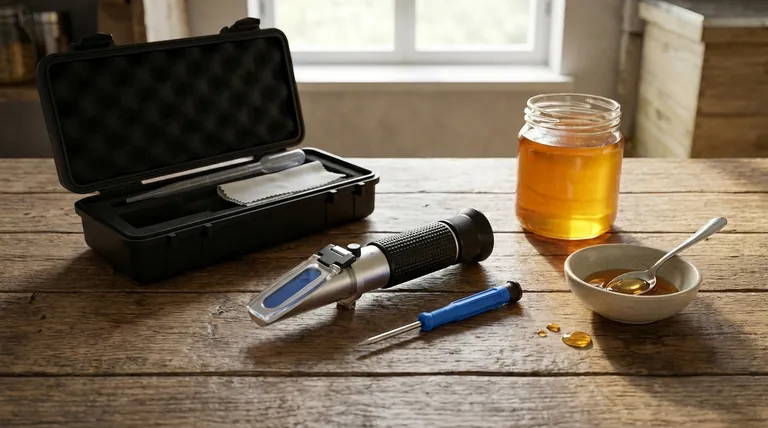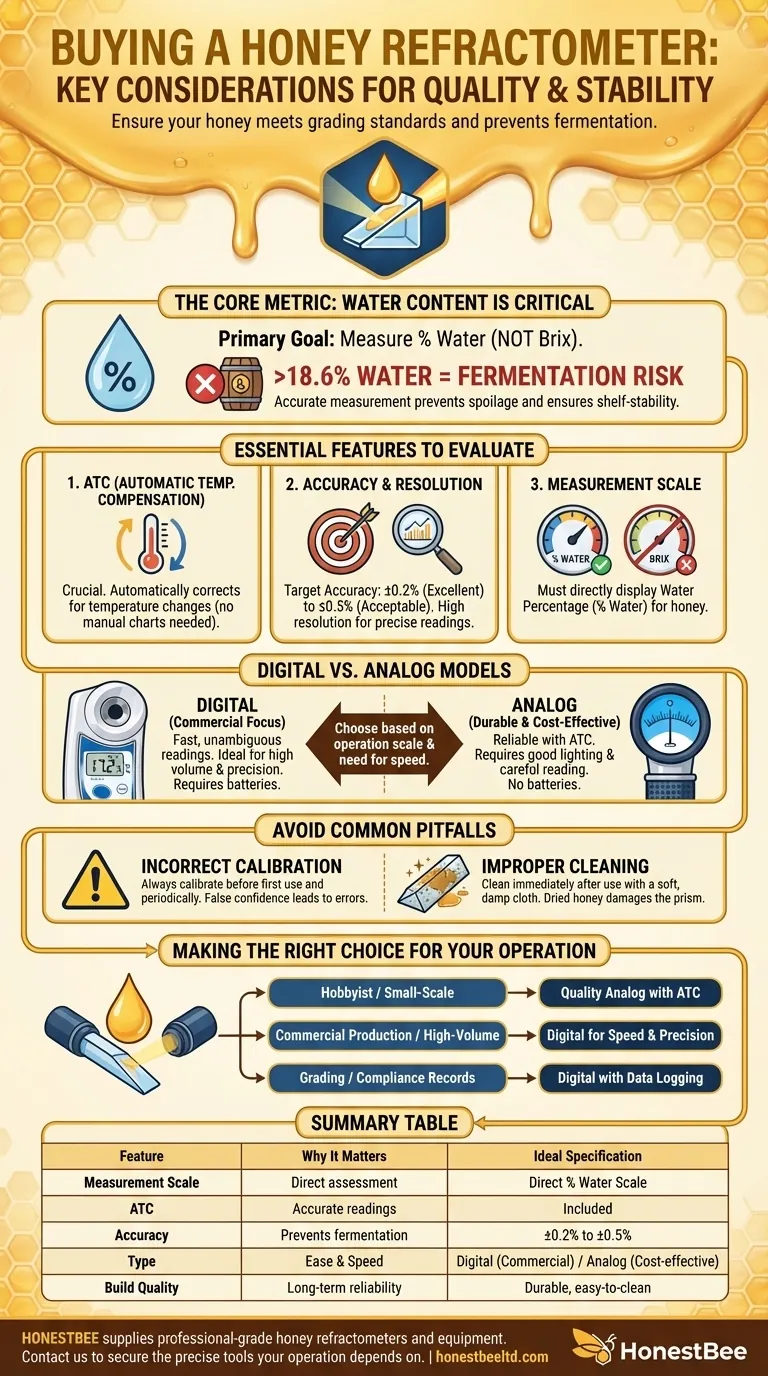When buying a honey refractometer, your primary considerations must be its measurement scale, accuracy, and inclusion of Automatic Temperature Compensation (ATC). A proper honey refractometer is specifically designed to measure water content, which is the critical factor for honey quality and stability. Features like a digital display and durable design are secondary but contribute to ease of use and longevity.
The goal is not just to buy a measurement tool, but to secure a reliable method for verifying honey quality. Your choice of refractometer directly impacts your ability to prevent fermentation, meet grading standards, and ensure the long-term stability of your product.

The Core Metric: Measuring Water Content
The primary purpose of a honey refractometer is to measure the percentage of water in your honey. This is the single most important factor in determining its grade and shelf-stability.
Why Water Content is Critical
Honey with a water content above 18.6% is at risk of fermenting. Fermentation spoils the honey, rendering it unsellable and unusable.
Accurate measurement ensures your honey is properly cured and safe for storage, bottling, and sale. It is a non-negotiable step for quality control.
The Correct Measurement Scale
A general-purpose refractometer, which often measures in Brix (sugar content), is not ideal. You need a model specifically calibrated for honey.
Look for a device that directly displays water percentage (% water). This eliminates the need for conversion charts and reduces the chance of user error, providing a clear, actionable reading.
Key Features to Evaluate in a Refractometer
Once you confirm a device is built for honey, several key features distinguish a reliable instrument from a frustrating one.
Automatic Temperature Compensation (ATC)
This is arguably the most critical feature. The refractive index of honey changes with temperature, which can skew your readings.
ATC technology automatically corrects the measurement to a standardized baseline temperature (usually 20°C / 68°F). Without it, you would need to let the honey and the tool sit until they reach the same specific temperature and then use a correction chart, which is inefficient and prone to error.
Accuracy and Resolution
Accuracy specifications tell you how close the reading is to the true value. For honey, an accuracy of ±0.2% is excellent, while ±0.5% is generally acceptable for most beekeepers.
Resolution is the smallest increment the scale displays (e.g., 0.1%). High resolution allows for more precise readings.
Digital vs. Analog Models
Analog refractometers are classic, durable, and cost-effective. You drop honey on the prism, close the lid, and look through an eyepiece to read a scale. They require good lighting and can be subjective to read.
Digital refractometers provide a clear, unambiguous number on an LCD screen. They are faster, easier to read, and eliminate any guesswork, but they are more expensive and require batteries.
Build Quality and Design
A well-built refractometer will last for years. Look for durable materials that can withstand the occasional knock or drop in a honey house environment.
Consider the ergonomics. The device should be comfortable to hold, and the sample plate should be easy to clean. A well-designed prism cover helps spread the honey evenly and remove air bubbles.
Understanding the Trade-offs
Choosing a refractometer involves balancing cost against features and reliability. A cheap, inaccurate tool is worse than no tool at all.
Price vs. Precision
Inexpensive analog models can be perfectly adequate, provided they have ATC and are calibrated correctly. Their main drawback is the potential for misreading the analog scale.
Higher-priced digital models offer undeniable advantages in speed and readability. For commercial operations where time is money and precise records are essential, the investment is easily justified.
The Pitfall of Incorrect Calibration
Any refractometer is useless if it isn't calibrated. Most models are calibrated with a special oil or a block of glass with a known refractive index.
Always calibrate your device before its first use and check it periodically, especially if it has been dropped. Failure to do so will give you false confidence in incorrect readings.
Ignoring Proper Use and Cleaning
A common mistake is failing to clean the prism immediately after use. Dried honey is difficult to remove and can damage the prism's coating or lead to inaccurate future readings.
Always use a soft, damp cloth for cleaning. Never submerge the device in water unless it is explicitly rated as waterproof.
Making the Right Choice for Your Operation
Select your tool based on the scale of your work and your tolerance for error.
- If your primary focus is hobbyist or small-scale beekeeping: A quality analog refractometer with ATC and a dedicated water-content scale offers the best balance of cost and performance.
- If your primary focus is commercial production or high-volume sales: A digital refractometer is a worthwhile investment for its speed, precision, and elimination of reading errors.
- If you need to maintain records for grading or compliance: A digital model, especially one with data logging capabilities, provides the accuracy and traceability required for professional standards.
Ultimately, a reliable refractometer is a fundamental tool for anyone serious about producing high-quality honey.
Summary Table:
| Feature | Why It Matters | Ideal Specification |
|---|---|---|
| Measurement Scale | Must measure % water, not Brix, for direct honey quality assessment. | Direct % Water Scale |
| Automatic Temperature Compensation (ATC) | Corrects for temperature changes, ensuring accurate readings without manual charts. | Included |
| Accuracy | Determines reliability in preventing fermentation (risk above 18.6% water). | ±0.2% to ±0.5% |
| Type (Analog/Digital) | Affects ease of use, speed, and readability for different operation scales. | Analog (cost-effective), Digital (commercial) |
| Build Quality | Withstands the honey house environment for long-term reliability. | Durable, easy-to-clean materials |
Ensure your honey meets the highest standards of quality and stability.
For commercial apiaries and beekeeping equipment distributors, the right refractometer is not just a tool—it's your first line of defense against fermentation and a critical component for meeting grading standards. HONESTBEE supplies a range of reliable, professional-grade honey refractometers and beekeeping equipment through our wholesale-focused operations.
Contact HONESTBEE today to discuss your specific needs and secure the precise equipment your operation depends on.
Visual Guide

Related Products
- Precision Honey Refractometer Instrument for Quality Assessment
- Digital Honey Refractometer for Precision Measurement of Optimal Honey Quality
- HONESTBEE 72 Frame Industrial Electric Honey Extractor for Beekeeping
- Plastic Hand Crank 2 Frame Honey Extractor Low Price
- 6 Frame Manual Stainless Steel Honey Extractor Beekeeping Equipment
People Also Ask
- Why is a honey refractometer considered essential for commercial beekeepers? Ensure Honey Quality and Profitability
- What is a honey refractometer and what is its purpose? Ensure Honey Quality and Prevent Spoilage
- What are the key points for proper usage of a honey refractometer? Ensure Accurate Moisture Readings Every Time
- What are the benefits of using a Pocket Digital Honey Refractometer? Achieve Precision & Speed in Honey Quality Control
- What are the key steps to using a honey refractometer? Ensure Honey Quality & Prevent Fermentation



















